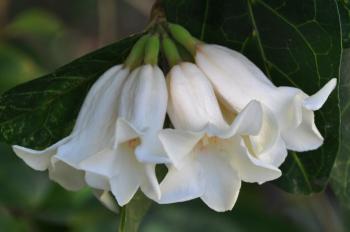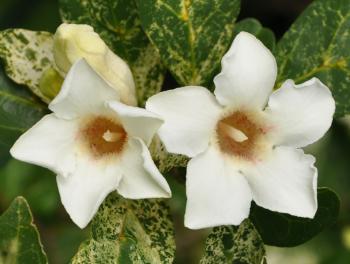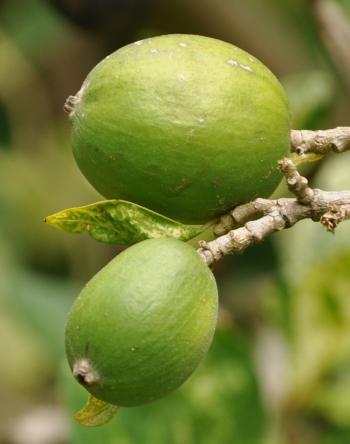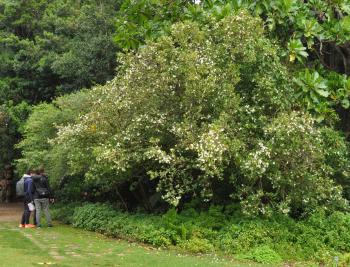Rothmannia globosa
Rothmannia globosa (Hochst.) Keay
Family: Rubiaceae
Common names: September bells, bell gardenia (Eng.); klokkies-valskatjiepiering (Afr.); umGubhe (Xhosa); umPhazane (Zulu); Thudwane (Venda); siKoba (Swati)
SA Tree No: 695
Introduction
Rothmannia globosa is a decorative small garden tree with fragrant white bell-shaped flowers in early summer.

Description
Description
This slender tree, usually 4-7 m in height, can reach 12 m depending on the climatic conditions. The bark is brown or dark grey, smooth when young but rougher in old age and marked in rectangular segments. The shiny simple leaves are oval or lanceolate with a paler underside which displays the yellow or reddish midrib and veins. Trees are usually evergreen but may be briefly deciduous.

The scented bell-shaped flowers are creamy white, usually with pink speckles in the throat, and are borne singly or in clusters of 2 to 4 on short side branches. They are about 25 mm long and 35 mm wide. The flowers are almost stalkless and appear in spring and early summer, from August to November. The trees are often in full bloom in September hence the common name.

The fruits are round, about 25 mm in diameter and green when young but turn brown as they ripen from January onwards.

Conservation Status
Status
Rothmannia globosa is assessed as Least Concern (LC) on the Red List of South African Plants, it is not threatened.
Distribution and habitat
Distribution description
The tree is found in coastal and dune bush along riverbanks and in evergreen forest from the Eastern Cape to Limpopo Province and Swaziland.
Derivation of name and historical aspects
History
The specific name globosa means roundish and refers to the shape of the fruit. Rothmannias are related to gardenias and Rothmannia capensis with larger flowers is also cultivated in gardens.

Ecology
Ecology
Monkeys, baboons and birds eat the fruit of the bell gardenia. Carpenter bees visit the flowers.
Uses
Use
In some parts of southern Africa the powdered roots are rubbed into incisions to treat leprosy. Mpondo men once used the shells of the fruit as clothing. The fruits are recorded as edible and the dried fruits are used to make necklaces.
Growing Rothmannia globosa
Grow
The plant is easily cultivated from seed in well-drained soil to which plenty of compost has been added. It is fairly fast growing and tolerates some frost and makes a beautiful small tree that is well suited to townhouse gardens.
References
- Coates Palgrave, M. 2002. Keith Coates Palgrave Trees of southern Africa, edn 3. Struik, Cape Town.
- Joffe, P. 2001. Creative gardening with indigenous plants. Briza Publications, Pretoria.
- Palmer, E. & Pitman, N. 1972. Trees of South Africa, vol. 3. Balkema, Cape Town.
- Watt, M. & Breyer-Brandwijk, M.G. 1962. Medicinal and poisonous plants of southern and eastern Africa, edn 2. Livingstone, London.
Credits
Khangela Joseph Baloyi
Pretoria National Botanical Garden
November 2005
with additions by Yvonne Reynolds
updated February 2017
Plant Attributes:
Plant Type: Tree
SA Distribution: Eastern Cape, KwaZulu-Natal, Limpopo, Mpumalanga
Soil type: Sandy, Loam
Flowering season: Spring, Early Summer
PH: Acid, Neutral
Flower colour: White, Cream
Aspect: Full Sun, Morning Sun (Semi Shade), Afternoon Sun (Semi Shade)
Gardening skill: Easy
Special Features:
Horticultural zones










Rate this article
Article well written and informative
Rate this plant
Is this an interesting plant?
Login to add your Comment
Back to topNot registered yet? Click here to register.